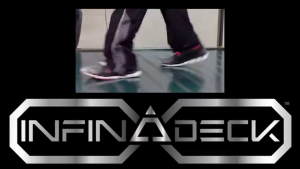George Burger's Infinadeck is the First Active (Non-Passive) Omnidirectional Treadmill for Virtual Reality
 Last year an amazing new product concept was introduced to the public – the Infinadeck, an omnidirectional treadmill designed to let the user move around in virtual worlds when accompanied by a VR headset (like the Oculus Rift).
Last year an amazing new product concept was introduced to the public – the Infinadeck, an omnidirectional treadmill designed to let the user move around in virtual worlds when accompanied by a VR headset (like the Oculus Rift).
Despite it's incredible potential as an accessory to the burgeoning virtual reality industry, most of us completely overlooked this commendable contribution and engineering feat as yet another futuristic sci-fi invention.
However, now that virtual reality headsets like the Oculus Rift and Sony's Project Morpheus are on the horizon (with both expected to be released within the next year) we feel that now is a great time to take a look at some of the recent breakthroughs in VR treadmill technology, one of the most exciting of which has been George Burger's Infinadeck.
You may be wondering why we're calling it “George Burger's” Infinadeck. Surprisingly enough, the entire prototype was designed and built by Mr. Burger himself, who happens to be the Director of New Product Development for Louisville Slugger (the same company that makes baseball bats). Apparently he's in charge of designing the machines that manufacture the company's bats.
The Infinadeck is unique because so far it is the only VR treadmill that takes an active (non-passive) approach to omnidirectional movement. In other words, while there a couple other VR treadmills that use the passive approach to let the user slide around on a low-friction stationary platform, the Infinadeck is different in that the parts are actually moving underneath the user's feet, thereby creating the more realistic sensation that the player is achieving lateral movement in the virtual world. Thus, one could argue that the Infinadeck is the only true VR treadmill that has been introduced thus far.
Before we continue, let's take a look at the Infinadeck in action:
How Does it Work?
Surprisingly, the complex-looking machine you see above consists primarily of only two motors and one belt. At first glance you might think there are many different belts, but in fact it is just one that has been wrapped around a conveyor in such a way to make it appear as many.
While the video above can do a better job of explaining the Infinadeck than us, here's a summarized explanation that Mr. Burger has given for using only one belt and two motors: First, the singular belt can be ran by one motor, thereby reducing manufacturing cost. Second, and perhaps more importantly, since the platform consists of one belt there's no need to synchronize RPMs between multiple belts, so the entire surface moves at the same speed, which of course is very important for helping the user maintain balance.
Speaking of which, the current version does not have a safety ring to prevent the user from falling, so that will certainly have to be added before this device can make it to the market. Even so, the current prototype could be used for slower applications in VR, which only require walking at a modest pace, such as virtual tourism or exploration.
When Will You Be Able to Buy One?
The current prototype version of the Infinadeck lacks the ability to detect which direction the user is trying to walk, so it has to be manually controlled so that the user can change directions. Of course, a consumer version would require adequate tracking capabilities to automatically change the direction of the treadmill immediately after detecting a change in the direction of the user. These changes would have to happen quick enough to prevent the user from losing balance, especially during actions like jumping and sharp turns.
Burger has stated that he designed the Infinadeck “with scalability in mind,” so that a production version could much lighter and more responsive, thereby allowing sudden stop-and-go movements that are not currently possible with the clunky and noisy prototype version.
With all of that said, it seems the Infinadeck has only made it to the proof-of-concept phase in its development thus far, so it will probably be a few more years before we see this type of VR treadmill on the market, and that's only if a few more design and manufacturing challenges can be overcome.
It is likely that the Infinadeck will become the next generation of VR treadmills, following behind the simpler, lighter, and more affordable passive systems like the Virtuix Omni and Cyberith Virtualizer, which will probably be released within the next year or two.
